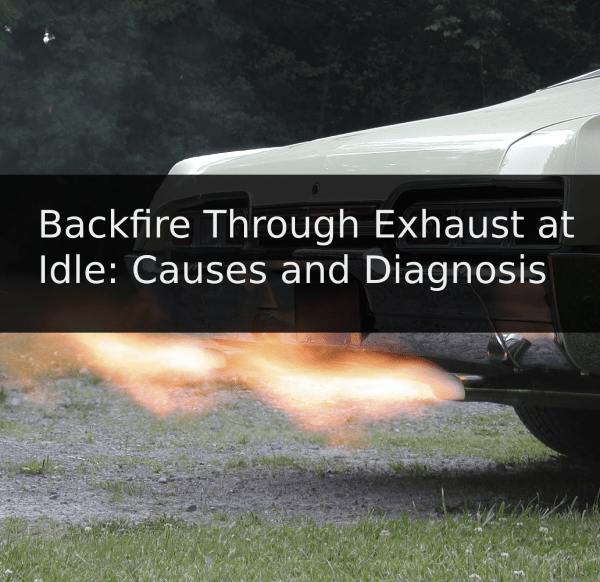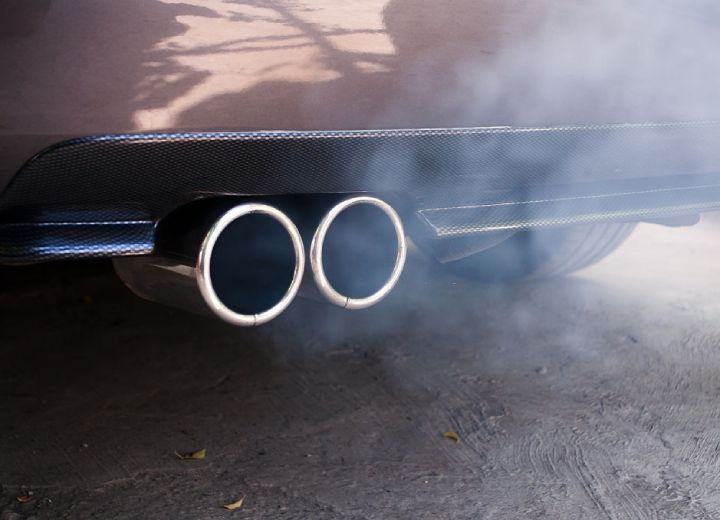All combustion is supposed to occur in the engine cylinders. If it happens somewhere else in your car, we call it backfiring. Backfiring occurs at the exhaust and is not desirable.
A backfiring car experiences a sudden loss of power and poor mileage per gallon. The engine becomes less efficient, and the popping sounds can be irritating. For these reasons, you should fix the problem to restore the condition of your car.
What causes backfire through the exhaust at idle, and how do you fix this problem? Read on for detailed explanations of possible causes and how to store backfiring.
What Causes Backfire Through the Exhaust At Idle?
Backfiring through the exhaust can result from different causes. The most common ones include engine running too rich, cracked distributor cap, a sudden drop in fuel pressure, etc. Let’s get into the details of these possible causes.

Small Leak in The Air Injection System That Feeds the Exhaust System
A leak in the ignition system that feeds the exhaust system or a leak in the exhaust system itself affects the air-fuel mixture ratio. More air gets into the system through these cracks, leading to unburned fuel in the exhaust. These residues finally explode, producing the popping sound you hear when your car backfires through the exhaust.
Sudden Drop in Fuel Pressure
A sudden drop in fuel pressure affects the fuel-air ratio in the engine cylinders. Less fuel is delivered, meaning combustion does not occur as efficiently as it should. This factor leads to the deposition of the unburned fuel, which causes backfiring through the exhaust.
Related content: Can You Drive Without An Exhaust Pipe?
Incorrect Ignition Timing to The Spark Plugs
Delayed ignition timing in the combustion chamber can lead to a car backfiring through the exhaust. The reason is that the delay introduced affects the usual operation of the cylinder and cylinder head.
That results in fuel burning when the exhaust valve is already open. The hot air-fuel mixture rushes to the exhaust and combines with flammable oxygen in the air at the tailpipe. It explodes, producing a loud bang. You may see fire at the exhaust tailpipe when your car backfires.
However, this problem is not common in modern vehicles. Computers accurately control ignition timing, meaning the air-fuel mixture always burns in the combustion chamber. It often happens in cars with carbureted engines with distributor caps.
Carbon Tracking on Spark Plug Wires
Carbon tracking happens in all vehicles with ignition coils or distributor caps. It is one of the most common problems in old automobiles, where the sparks can go crossways from one wire to another, forming a carbon track. This process escalates due to varying environmental factors. And if it occurs regularly, the carbon that causes the short eventually causes a backfire.
Another possible cause of carbon tracking is the direct mounting of spark plug wires or ignition coils on the spark plug. This situation forces the electrical spark to split and follow a different path, leaving fuel in the cylinder.
When the vehicle generates the next spark, it ignites the fuel left behind in the previous cycle. That happens when the exhaust valve is already open. A backfire occurs as the now-ignited fuel mixture rushes through the exhaust.
Cracked Distributor Cap
This is a common problem in cars with distributor caps and wire sets to dispense electrical signals instead of ignition coils. A cracked distributor cap may allow in moisture, which causes the spark from one cylinder to jump into another when the exhaust valve is now open. That causes backfiring through the exhaust pipe.
Running Too Rich
A high fuel-to-air ratio or running rich condition happens when the fuel supply is higher than the air. An engine that runs rich burns fuel slowly, and the unburned is forced through the exhaust when the exhaust valve opens in the next cycle.
The unburned gasoline causes backfiring when it gets to the tailpipe when it mixes with oxygen from the air. The high fuel-to-air ratio often results from a clogged or blocked air filter.
Related content: How Much Does It Cost to Get Your Exhaust Welded?
How Do I Stop My Exhaust from Backfiring?
Backfiring through the exhaust at idle is an undesirable condition that needs immediate fixing. Fortunately, diagnosis and troubleshooting are pretty straightforward. You can do it at the garage or take your car to an auto repair shop for help.
The first step is to scan your car with an OBD2 tool for any stored fault codes. Most causes of exhaust backfires turn on the Check Engine Light. If you find a diagnostic trouble code stored, it is the pointer to the problem. But if there is no clue or you don’t have an OBD2 diagnosis tool, consider the following fixes:
Check The Engine Timing Belt
The engine timing belt is a crucial component that ensures the engine functions properly. Check it to ensure that it is in good condition. If it is worn, frayed, or compromised, replace it with a new one.
Check Spark Plugs
Spark plugs determine how the air-fuel mixture burns in the combustion chamber. If they are faulty, they interfere with the usual combustion cycle. So, check them for carbon buildup and corrosion and replace them if any of these conditions is evident.
Check Spark Plug Wires
Spark plug wires feed electrical signals to the spark plugs. The air-fuel ratio gets affected if they have any problems, such as shorts or open circuits. So, checking, testing, and replacing spark plug wires are excellent ideas to stop backfiring from the exhaust.
Replace Cracked Distributor Cap
Inspect the distributor cap if your vehicle has one and replace it if cracked. As mentioned, a cracked distributor cap allows for moisture that potentially causes a spark from one cylinder to fire another. That means replacing the damaged component can stop backfiring.
Check Fuel System
A fuel system consists of a carburetor, fuel pump, and fuel injectors. These components work together to deliver the right amount of fuel. If, for instance, the fuel pump is faulty, the fuel pressure drops. This will result in a lean condition, which also causes backfiring. Check every fuel system component and fix or replace the damaged ones.
Check Air Filter
Changing the air filter is part of regular vehicle maintenance. However, it may get clogged faster, depending on the road conditions. Check your air filter and replace it if blocked with dust and other solid debris.
Check the Upstream Exhaust Leak
A leak in the exhaust will cause unburned fuel to suddenly combust, causing misfiring. Check your exhaust and seal any leaks. Be cautious when handling this task because of the dangers involved.
Final Remarks
Backfiring through the exhaust can result from many different defects in your car. However, the most common ones include leaks in the injection and exhaust systems, sudden drops in fuel pressure, cracked distributor caps, carbon tracking on spark plug wires, etc.
Regardless of the cause, backfire is a problem that requires an immediate solution. Diagnose and troubleshoot your car for all possible causes and fix the problem. You may need the help of an experienced mechanic if you are not a DIYer.
Brian is an auto technician who writes DIY repair articles and creates how-to videos for MechanicAsk. He focuses on common repairs like brakes, oil changes, and lighting. Brian draws on his 5 years of dealership experience to explain repairs in an easy-to-follow manner, even for novice do-it-yourselfers. His technical articles always include detailed tool lists, supply checklists, and visual guides.








